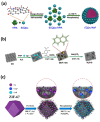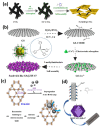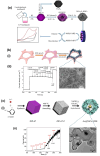Recent Advances in MOF-Based Materials for Biosensing Applications
- PMID: 40285162
- PMCID: PMC12031313
- DOI: 10.3390/s25082473
Recent Advances in MOF-Based Materials for Biosensing Applications
Abstract
Metal-organic frameworks (MOFs) or coordination polymers have gained enormous interest in recent years due to their extraordinary properties, including their high surface area, tunable pore size, and ability to form nanocomposites with various functional materials. MOF materials possess redox-active properties that are beneficial for electrochemical sensing applications. Furthermore, the tunable pore size and high surface area improve the adsorption or immobilization of enzymes, which can enhance the sensitivity and selectivity for specific analytes. Additionally, MOF-derived metal sulfides, phosphides, and nitrides demonstrate superior electrical conductivity and structural stability, ideal for electrochemical sensing. Moreover, the functionalization of MOFs further increases sensitivity by enhancing electrode-analyte interactions. The inclusion of carbon materials within MOFs enhances their electrical conductivity and reduces background current through optimized loading, preventing agglomeration and ensuring uniform distribution. Noble metals immobilized on MOFs offer improved stability and catalytic performance, providing larger surface areas and uniform nanoparticle dispersion. This review focuses on recent developments in MOF-based biosensors specifically for glucose, dopamine, H2O2, ascorbic acid, and uric acid sensing.
Keywords: MOF-derived carbon composites; MOF-derived metal oxides; MOF–noble metal composite; biosensing; metal–organic frameworks; phosphides; sulfides.
Conflict of interest statement
The authors declare no conflicts of interest.
Figures















Similar articles
-
Electroactive metal-organic framework composites: Design and biosensing application.Biosens Bioelectron. 2019 Dec 15;146:111743. doi: 10.1016/j.bios.2019.111743. Epub 2019 Sep 30. Biosens Bioelectron. 2019. PMID: 31586760 Review.
-
Employing Conductive Metal-Organic Frameworks for Voltammetric Detection of Neurochemicals.J Am Chem Soc. 2020 Jul 8;142(27):11717-11733. doi: 10.1021/jacs.9b13402. Epub 2020 Jun 28. J Am Chem Soc. 2020. PMID: 32155057
-
Recent advances in metal/covalent organic framework-based electrochemical aptasensors for biosensing applications.Dalton Trans. 2021 Oct 19;50(40):14091-14104. doi: 10.1039/d1dt02360h. Dalton Trans. 2021. PMID: 34609402 Review.
-
Redefining Metal Organic Frameworks in Biosensors: Where Are We Now?ACS Appl Mater Interfaces. 2025 Mar 5;17(9):13246-13278. doi: 10.1021/acsami.4c19307. Epub 2025 Feb 21. ACS Appl Mater Interfaces. 2025. PMID: 39984305 Review.
-
Controllable ion design in flexible metal organic framework film for performance regulation of electrochemical biosensing.Biosens Bioelectron. 2024 Sep 15;260:116433. doi: 10.1016/j.bios.2024.116433. Epub 2024 May 27. Biosens Bioelectron. 2024. PMID: 38820721
Cited by
-
Recent Advancements in Lateral Flow Assays for Food Mycotoxin Detection: A Review of Nanoparticle-Based Methods and Innovations.Toxins (Basel). 2025 Jul 11;17(7):348. doi: 10.3390/toxins17070348. Toxins (Basel). 2025. PMID: 40711159 Free PMC article. Review.
References
-
- Zhou H.C., Long J.R., Yaghi O.M. Introduction to Metal–Organic Frameworks. Chem. Rev. 2012;112:673–674. - PubMed
-
- Li H., Eddaoudi M., O’Keeffe M., Yaghi O.M. Design and synthesis of an exceptionally stable and highly porous metal-organic framework. Nature. 1999;402:276–279. doi: 10.1038/46248. - DOI
-
- Stock N., Biswas S. Synthesis of Metal–Organic Frameworks (MOFs): Routes to Various MOF Topologies, Morphologies, and Composites. Chem. Rev. 2012;112:933–969. - PubMed
-
- Horcajada P., Gref R., Baati T., Allan P.K., Maurin G., Couvreur P., Férey G., Morris R.E., Serre C. Metal–Organic Frameworks in Biomedicine. Chem. Rev. 2012;112:1232–1268. - PubMed
Publication types
MeSH terms
Substances
LinkOut - more resources
Full Text Sources

